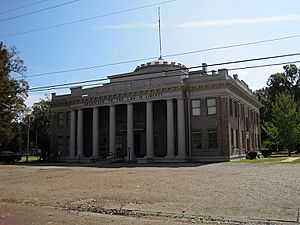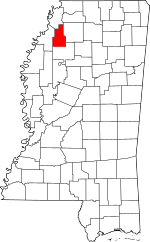Quitman County, Mississippi facts for kids
Quick facts for kids
Quitman County
|
|
|---|---|

Quitman County Courthouse
|
|

Location within the U.S. state of Mississippi
|
|
 Mississippi's location within the U.S. |
|
| Country | |
| State | |
| Founded | 1877 |
| Named for | John A. Quitman |
| Seat | Marks |
| Largest town | Marks |
| Area | |
| • Total | 406 sq mi (1,050 km2) |
| • Land | 405 sq mi (1,050 km2) |
| • Water | 1.4 sq mi (4 km2) 0.3% |
| Population
(2020)
|
|
| • Total | 6,176 |
| • Density | 15.212/sq mi (5.873/km2) |
| Time zone | UTC−6 (Central) |
| • Summer (DST) | UTC−5 (CDT) |
| Congressional district | 2nd |
Quitman County is a county located in the state of Mississippi in the United States. In 2020, about 6,176 people lived there. This makes it one of the least populated counties in Mississippi. The main town and county seat is Marks. The county is named after John A. Quitman. He was the Governor of Mississippi two times, from 1835 to 1836 and again from 1850 to 1851.
Quitman County is found in the Mississippi Delta region. This area is known for its rich soil and history.
Contents
History of Quitman County
Quitman County was created in 1877. It was formed from parts of four other counties: Tunica, Coahoma, Panola, and Tallahatchie. A man named Leopold Marks helped make this happen. He was a representative from Tunica County.
Farming and Population Changes
The county was mainly developed for growing cotton. Many areas near the river were not farmed until the late 1800s. As more land was cleared for farming, the number of people living in the county grew. The population reached its highest point in 1940.
Later, new machines were used for farming. This meant fewer people were needed to work on farms. Many African Americans moved away during the Great Migration. They went to big industrial cities in the North and Midwest, like St. Louis and Chicago.
The Poor People's Campaign
Martin Luther King Jr. wanted the Poor People's Campaign to start in Quitman County. He saw how much poverty there was. On March 18, 1968, King visited the town of Marks. He saw a teacher giving black schoolchildren a small lunch. It was just a slice of apple and some crackers. This made him very sad.
After King passed away, the southern part of the Campaign began in Quitman County. People rode a train of mules all the way to Washington, D.C.. They wanted to protest about economic problems. Willie Bolden, who led the mule train, said that some white citizens in Marks bothered them. They would drive by honking their horns to scare the mules. Today, people in Quitman County are trying to attract visitors. They want to share the county's role in the Poor People's Campaign.
Geography and Location
Quitman County has a total area of about 406 square miles. Most of this is land, about 405 square miles. Only a small part, about 1.4 square miles, is water. It is one of the smallest counties in Mississippi.
Main Roads and Highways
Neighboring Counties
Quitman County shares borders with four other counties:
- Tunica County (to the north)
- Panola County (to the east)
- Tallahatchie County (to the south)
- Coahoma County (to the west)
Protected Natural Areas
Part of the Coldwater River National Wildlife Refuge is located in Quitman County. This area helps protect wildlife.
Population Changes
The population of Quitman County has gone down a lot since 1940. This is because fewer farm workers were needed. The population has dropped by more than two-thirds since its highest point.
| Historical population | |||
|---|---|---|---|
| Census | Pop. | %± | |
| 1880 | 1,407 | — | |
| 1890 | 3,286 | 133.5% | |
| 1900 | 5,435 | 65.4% | |
| 1910 | 11,593 | 113.3% | |
| 1920 | 19,861 | 71.3% | |
| 1930 | 25,304 | 27.4% | |
| 1940 | 27,191 | 7.5% | |
| 1950 | 25,885 | −4.8% | |
| 1960 | 21,019 | −18.8% | |
| 1970 | 15,888 | −24.4% | |
| 1980 | 12,636 | −20.5% | |
| 1990 | 10,490 | −17.0% | |
| 2000 | 10,117 | −3.6% | |
| 2010 | 8,223 | −18.7% | |
| 2020 | 6,176 | −24.9% | |
| 2023 (est.) | 5,546 | −32.6% | |
| U.S. Decennial Census 1790-1960 1900-1990 1990-2000 2010-2013 |
|||
People in 2020
| Race | Num. | Perc. |
|---|---|---|
| White (not Hispanic) | 1,484 | 24.03% |
| Black or African American (not Hispanic) | 4,546 | 73.61% |
| Native American | 1 | 0.02% |
| Asian | 12 | 0.19% |
| Pacific Islander | 3 | 0.05% |
| Other/Mixed | 109 | 1.76% |
| Hispanic or Latino | 21 | 0.34% |
In 2020, there were 6,176 people living in Quitman County. There were 3,027 households and 1,833 families.
People in 2010
In 2010, there were 8,223 people in the county.
- About 69.6% were Black or African American.
- About 29.0% were White.
- A small number were Native American (0.2%), Asian (0.1%), or other races.
- About 0.7% of people were Hispanic or Latino.
Education in Quitman County
In 1969, a judge ruled that schools in Quitman County were unfairly separated by race. The school board was put under the watch of a federal court. This order was still in place in 1993.
By 1975, most African-American students in Quitman County went to public schools. However, most white students had moved to new private schools. This situation continues today. In 2007, the Mississippi Department of Education found that almost all students in the public school district were African American (97.92%). Only a small number were White (1.81%) or Hispanic (0.27%).
Schools in Quitman County are still mostly separated by race. White students usually go to private schools. Black children attend the local public schools.
| School | Total Students | White Students | Black Students | Note |
|---|---|---|---|---|
| Delta Academy (Private) | 175 | 147 (84.0%) | 17 (9.7%) | |
| M. S. Palmer High School (Public) | 351 | 4 (1.1%) | 347 (98.9%) | |
| Combined (Public plus private) | 526 | 151 (28.7%) | 364 (69.2%) |
- Public School Districts
- Quitman County School District - This is the only public school district in the county.
- Private Schools
- Delta Academy (in Marks)
Towns and Communities
City
- Marks (This is the county seat, the main town)
Towns
- Crenshaw (mostly in Panola County)
- Crowder (partly in Panola County)
- Falcon
- Lambert
- Sledge
Census-Designated Place
- Darling (This is a community that the census bureau counts)
Other Small Communities
- Allen
- Barksdale
- Belen
- Birdie
- Bobo
- Chancy
- Denton
- Essex
- Hinchcliff
- Locke Station (partly in Panola County)
- Longstreet
- Oliverfried
- Riverview
- Sabino
- Vance (partly in Tallahatchie County)
- Walnut
- West Marks
- Yarbrough
Famous People from Quitman County
- Earl Hooker (1929–1970) — a well-known blues guitarist.
- Charley Pride (1934–2020) — a famous country music singer.
- Snooky Pryor (1921–2006) — a talented harmonica player.
- Sunnyland Slim (1907–1995) — a blues piano player.
- Fred Smith (born 1944) — the founder and CEO of FedEx.
See also
 In Spanish: Condado de Quitman (Misisipi) para niños
In Spanish: Condado de Quitman (Misisipi) para niños

